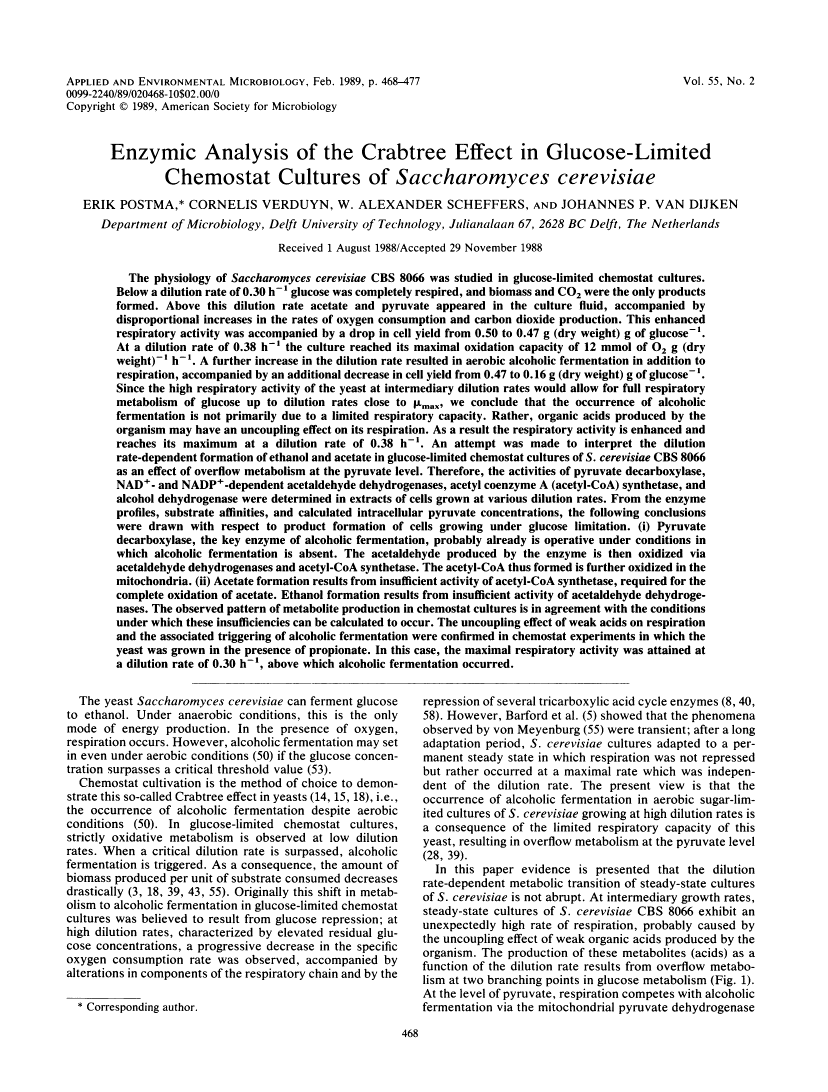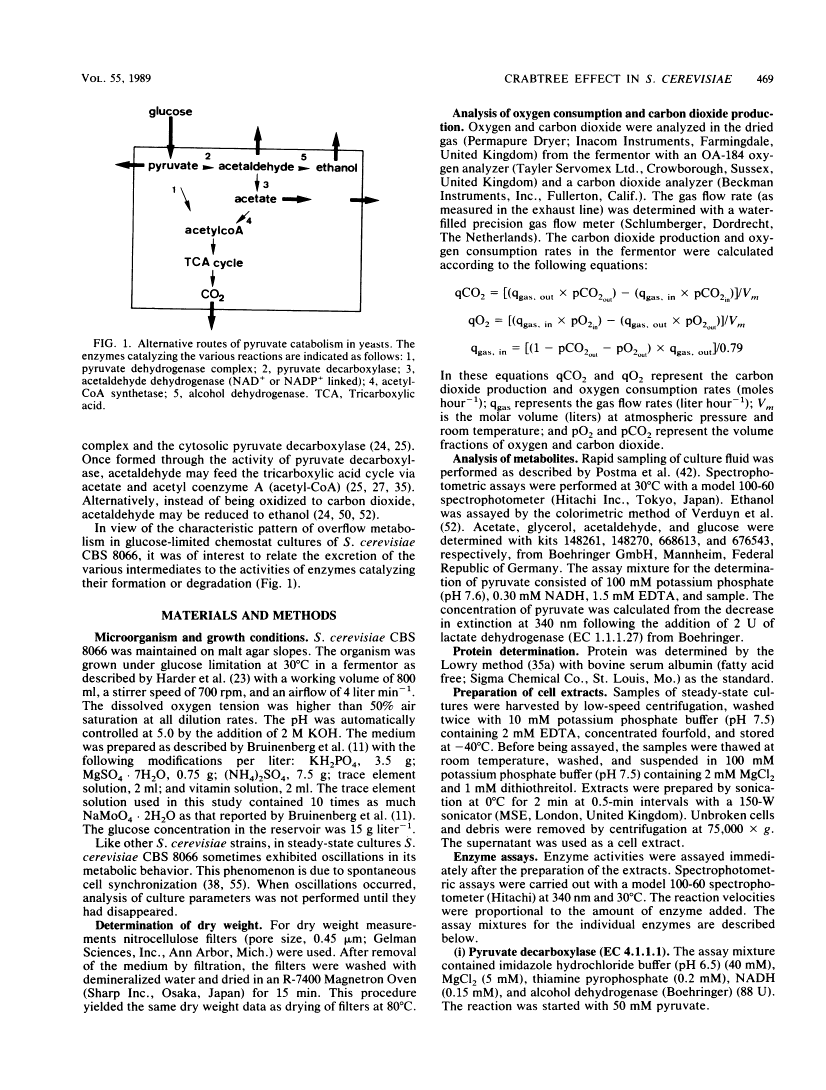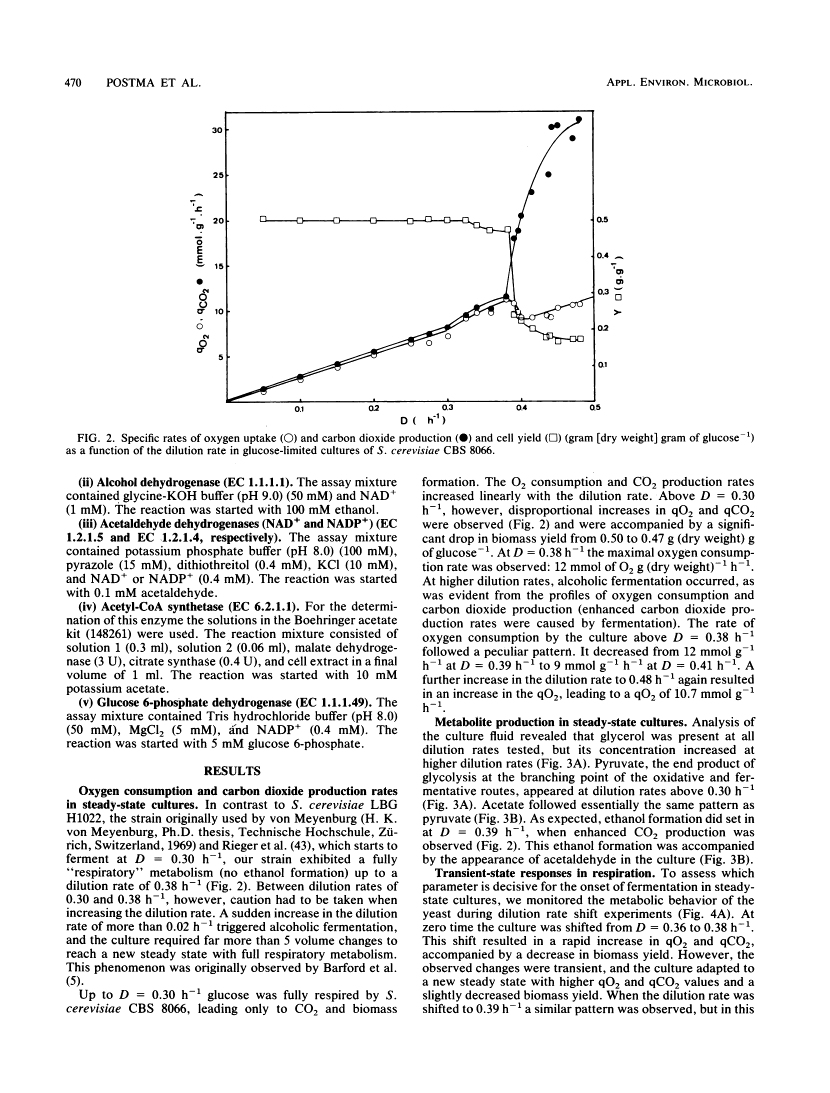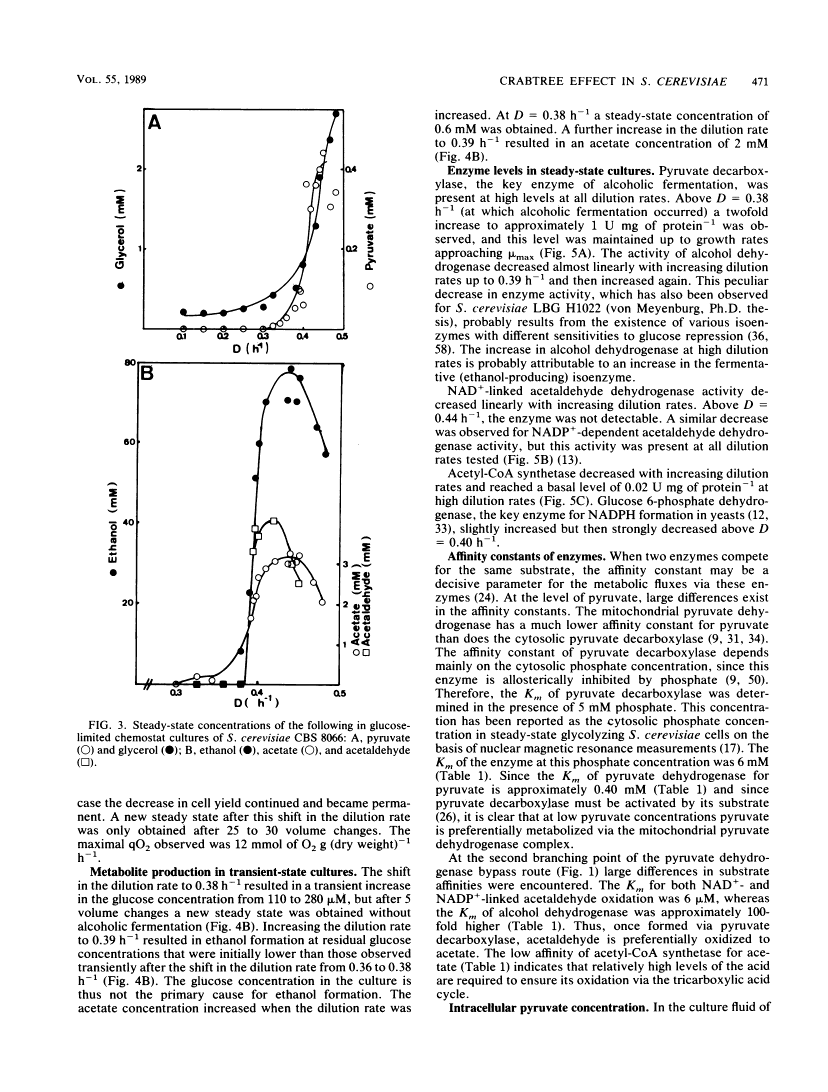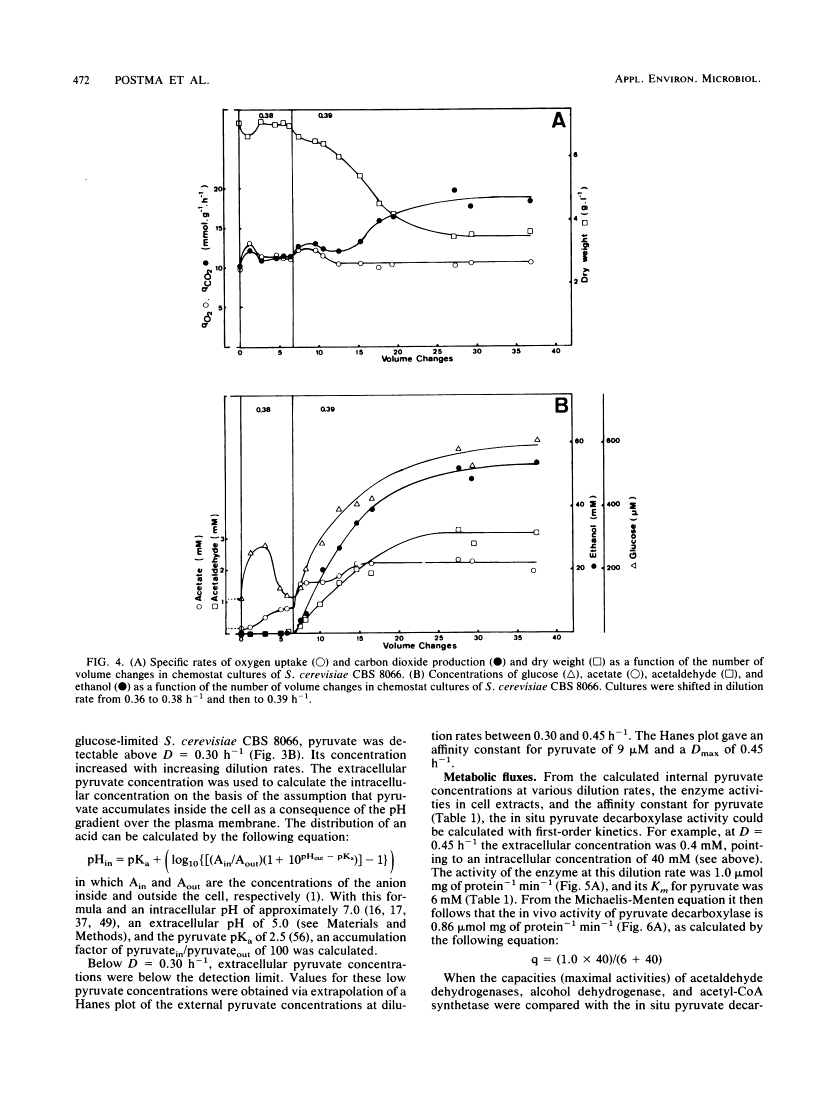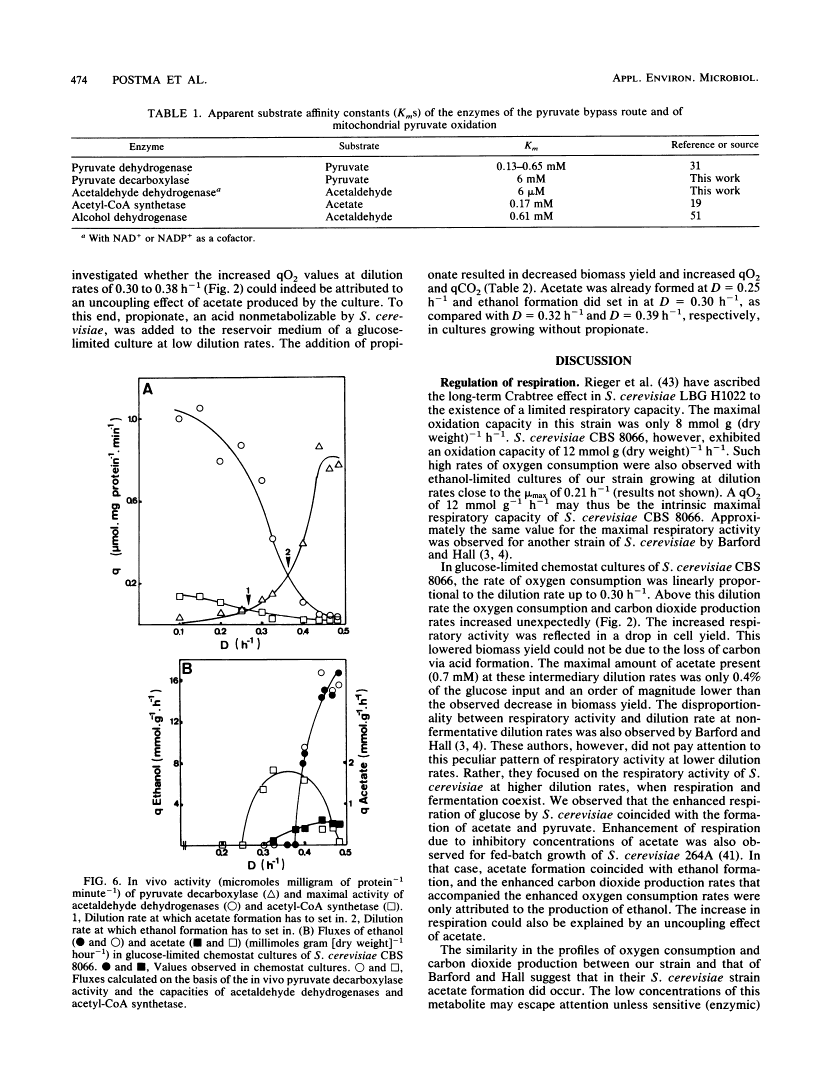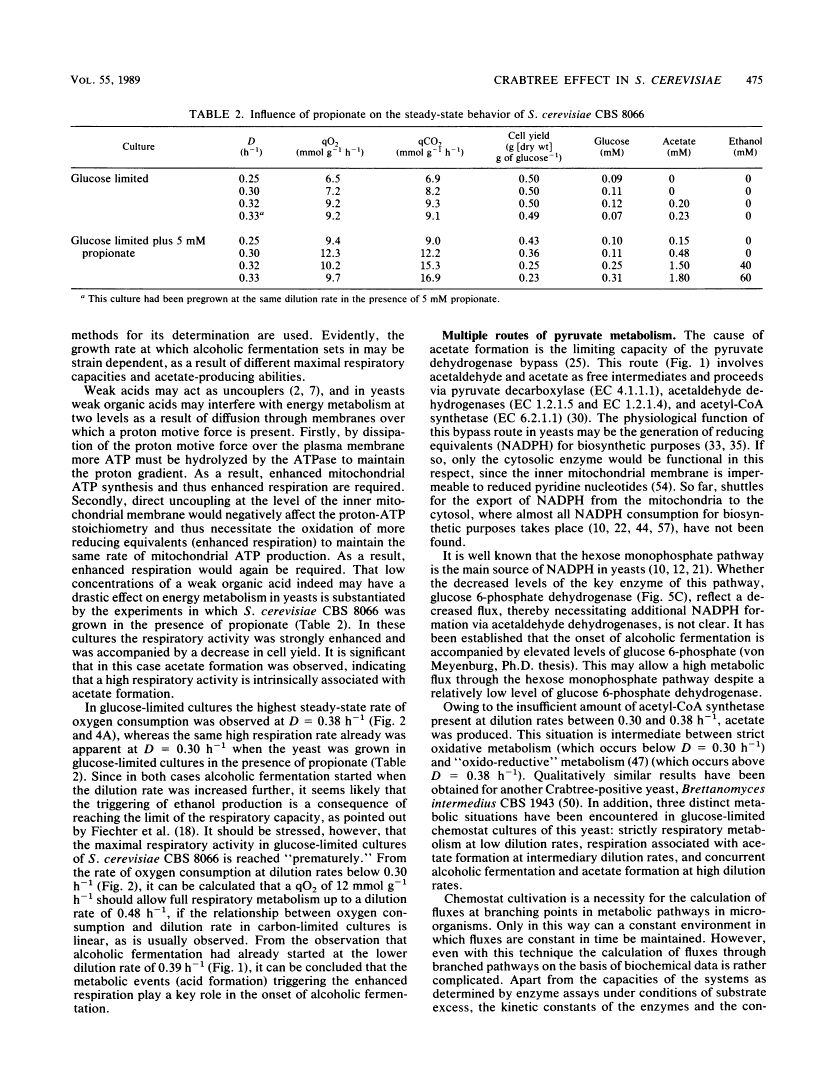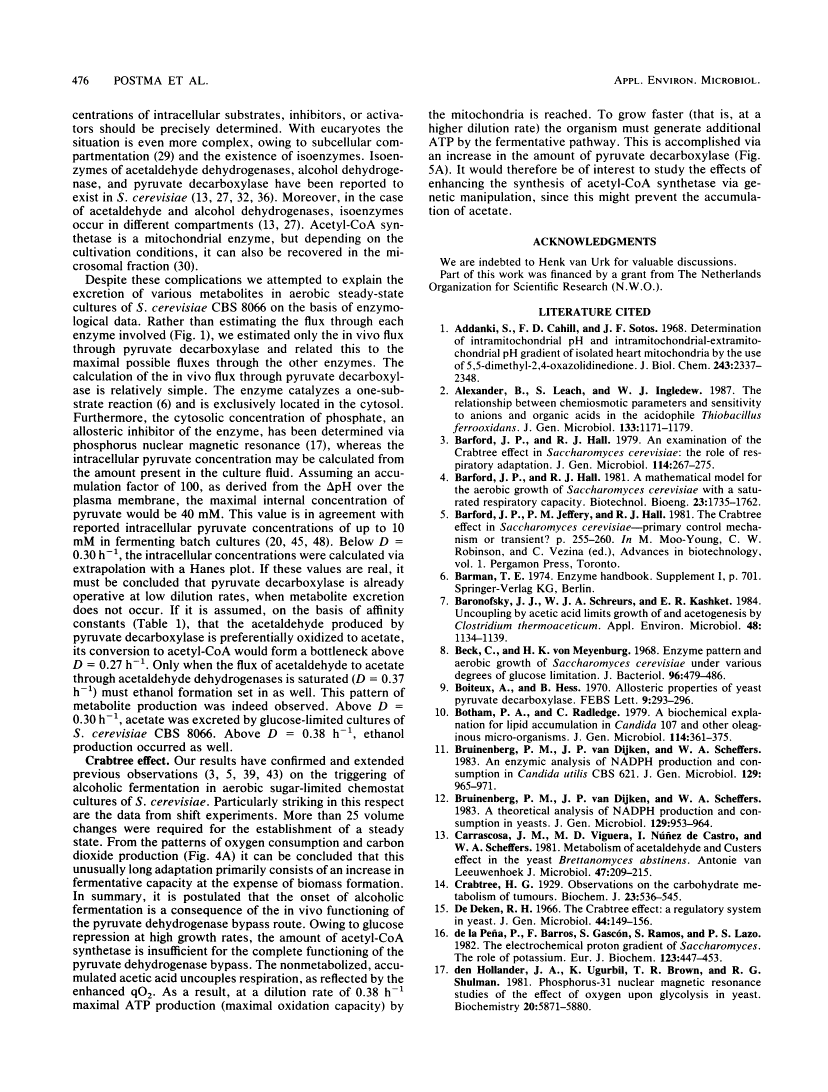Abstract
Free full text

Enzymic analysis of the crabtree effect in glucose-limited chemostat cultures of Saccharomyces cerevisiae.
Abstract
The physiology of Saccharomyces cerevisiae CBS 8066 was studied in glucose-limited chemostat cultures. Below a dilution rate of 0.30 h-1 glucose was completely respired, and biomass and CO2 were the only products formed. Above this dilution rate acetate and pyruvate appeared in the culture fluid, accompanied by disproportional increases in the rates of oxygen consumption and carbon dioxide production. This enhanced respiratory activity was accompanied by a drop in cell yield from 0.50 to 0.47 g (dry weight) g of glucose-1. At a dilution rate of 0.38 h-1 the culture reached its maximal oxidation capacity of 12 mmol of O2 g (dry weight)-1 h-1. A further increase in the dilution rate resulted in aerobic alcoholic fermentation in addition to respiration, accompanied by an additional decrease in cell yield from 0.47 to 0.16 g (dry weight) g of glucose-1. Since the high respiratory activity of the yeast at intermediary dilution rates would allow for full respiratory metabolism of glucose up to dilution rates close to mumax, we conclude that the occurrence of alcoholic fermentation is not primarily due to a limited respiratory capacity. Rather, organic acids produced by the organism may have an uncoupling effect on its respiration. As a result the respiratory activity is enhanced and reaches its maximum at a dilution rate of 0.38 h-1. An attempt was made to interpret the dilution rate-dependent formation of ethanol and acetate in glucose-limited chemostat cultures of S. cerevisiae CBS 8066 as an effect of overflow metabolism at the pyruvate level. Therefore, the activities of pyruvate decarboxylase, NAD+- and NADP+-dependent acetaldehyde dehydrogenases, acetyl coenzyme A (acetyl-CoA) synthetase, and alcohol dehydrogenase were determined in extracts of cells grown at various dilution rates. From the enzyme profiles, substrate affinities, and calculated intracellular pyruvate concentrations, the following conclusions were drawn with respect to product formation of cells growing under glucose limitation. (i) Pyruvate decarboxylase, the key enzyme of alcoholic fermentation, probably already is operative under conditions in which alcoholic fermentation is absent. The acetaldehyde produced by the enzyme is then oxidized via acetaldehyde dehydrogenases and acetyl-CoA synthetase. The acetyl-CoA thus formed is further oxidized in the mitochondria. (ii) Acetate formation results from insufficient activity of acetyl-CoA synthetase, required for the complete oxidation of acetate. Ethanol formation results from insufficient activity of acetaldehyde dehydrogenases.(ABSTRACT TRUNCATED AT 400 WORDS)
Full text
Full text is available as a scanned copy of the original print version. Get a printable copy (PDF file) of the complete article (1.8M), or click on a page image below to browse page by page. Links to PubMed are also available for Selected References.
Selected References
These references are in PubMed. This may not be the complete list of references from this article.
- Addanki A, Cahill FD, Sotos JF. Determination of intramitochondrial pH and intramitochondrial-extramitochondrial pH gradient of isolated heart mitochondria by the use of 5,5-dimethyl-2,4-oxazolidinedione. I. Changes during respiration and adenosine triphosphate-dependent transport of Ca++, Mg++, and Zn++. J Biol Chem. 1968 May 10;243(9):2337–2348. [Abstract] [Google Scholar]
- Baronofsky JJ, Schreurs WJ, Kashket ER. Uncoupling by Acetic Acid Limits Growth of and Acetogenesis by Clostridium thermoaceticum. Appl Environ Microbiol. 1984 Dec;48(6):1134–1139. [Europe PMC free article] [Abstract] [Google Scholar]
- Beck C, von Meyenburg HK. Enzyme pattern and aerobic growth of Saccharomyces cerevisiae under various degrees of glucose limitation. J Bacteriol. 1968 Aug;96(2):479–486. [Europe PMC free article] [Abstract] [Google Scholar]
- Boiteux A, Hess B. Allosteric properties of yeast pyruvate decarboxylase. FEBS Lett. 1970 Aug 31;9(5):293–296. [Abstract] [Google Scholar]
- Botham PA, Ratledge C. A biochemical explanation for lipid accumulation in Candida 107 and other oleaginous micro-organisms. J Gen Microbiol. 1979 Oct;114(2):361–375. [Abstract] [Google Scholar]
- Bruinenberg PM, van Dijken JP, Scheffers WA. An enzymic analysis of NADPH production and consumption in Candida utilis. J Gen Microbiol. 1983 Apr;129(4):965–971. [Abstract] [Google Scholar]
- Carrascosa JM, Viguera MD, Núez de Castro I, Scheffers WA. Metabolism of acetaldehyde and custers effect in the yeast. Antonie Van Leeuwenhoek. 1981;47(3):209–215. [Abstract] [Google Scholar]
- Crabtree HG. Observations on the carbohydrate metabolism of tumours. Biochem J. 1929;23(3):536–545. [Europe PMC free article] [Abstract] [Google Scholar]
- De Deken RH. The Crabtree effect: a regulatory system in yeast. J Gen Microbiol. 1966 Aug;44(2):149–156. [Abstract] [Google Scholar]
- de la Peña P, Barros F, Gascón S, Ramos S, Lazo PS. The electrochemical proton gradient of Saccharomyces. The role of potassium. Eur J Biochem. 1982 Apr 1;123(2):447–453. [Abstract] [Google Scholar]
- den Hollander JA, Ugurbil K, Brown TR, Shulman RG. Phosphorus-31 nuclear magnetic resonance studies of the effect of oxygen upon glycolysis in yeast. Biochemistry. 1981 Sep 29;20(20):5871–5880. [Abstract] [Google Scholar]
- Fiechter A, Fuhrmann GF, Käppeli O. Regulation of glucose metabolism in growing yeast cells. Adv Microb Physiol. 1981;22:123–183. [Abstract] [Google Scholar]
- Frenkel EP, Kitchens RL. Acetyl-CoA synthetase from bakers' yeast (Saccharomyces cerevisiae). Methods Enzymol. 1981;71(Pt 100):317–324. [Abstract] [Google Scholar]
- Gancedo JM, Gancedo C. Concentrations of intermediary metabolites in yeast. Biochimie. 1973;55(2):205–211. [Abstract] [Google Scholar]
- Gumaa KA, Greenbaum AL, McLean P. Adaptive changes in satellite systems related to lipogenesis in rat and sheep mammary gland and in adipose tissue. Eur J Biochem. 1973 Apr 2;34(1):188–198. [Abstract] [Google Scholar]
- Harder W, Visser K, Kuenen JG. Laboratory fermenter with an improved magnetic drive. Lab Pract. 1974 Nov;23(11):644–645. [Abstract] [Google Scholar]
- HOLZER H. Regulation of carbohydrate metabolism by enzyme competition. Cold Spring Harb Symp Quant Biol. 1961;26:277–288. [Abstract] [Google Scholar]
- HOLZER H, GOEDDE HW. Zwei Wege von Pyruvat zu Acetyl-Coenzym A in Hefe. Biochem Z. 1957;329(3):175–191. [Abstract] [Google Scholar]
- Hübner G, Weidhase R, Schellenberger A. The mechanism of substrate activation of pyruvate decarboxylase: a first approach. Eur J Biochem. 1978 Dec 1;92(1):175–181. [Abstract] [Google Scholar]
- Jacobson MK, Bernofsky C. Mitochondrial acetaldehyde dehydrogenase from Saccharomyces cerevisiae. Biochim Biophys Acta. 1974 Jun 18;350(2):277–291. [Abstract] [Google Scholar]
- Käppeli O. Regulation of carbon metabolism in Saccharomyces cerevisiae and related yeasts. Adv Microb Physiol. 1986;28:181–209. [Abstract] [Google Scholar]
- Klein HP, Jahnke L. Variations in the localization of acetyl-coenzyme A synthetase in aerobic yeast cells. J Bacteriol. 1971 May;106(2):596–602. [Europe PMC free article] [Abstract] [Google Scholar]
- Kresze GB, Ronft H. Pyruvate dehydrogenase complex from baker's yeast. 1. Purification and some kinetic and regulatory properties. Eur J Biochem. 1981 Oct;119(3):573–579. [Abstract] [Google Scholar]
- Kuo DJ, Dikdan G, Jordan F. Resolution of brewers' yeast pyruvate decarboxylase into two isozymes. J Biol Chem. 1986 Mar 5;261(7):3316–3319. [Abstract] [Google Scholar]
- Lagunas R, Gancedo JM. Reduced pyridine-nucleotides balance in glucose-growing Saccharomyces cerevisiae. Eur J Biochem. 1973 Aug 1;37(1):90–94. [Abstract] [Google Scholar]
- LaNoue KF, Schoolwerth AC. Metabolite transport in mitochondria. Annu Rev Biochem. 1979;48:871–922. [Abstract] [Google Scholar]
- Llorente N, de Castro IN. Physiological role of yeasts NAD(P)+ and NADP+-linked aldehyde dehydrogenases. Rev Esp Fisiol. 1977 Jun;33(2):135–142. [Abstract] [Google Scholar]
- LOWRY OH, ROSEBROUGH NJ, FARR AL, RANDALL RJ. Protein measurement with the Folin phenol reagent. J Biol Chem. 1951 Nov;193(1):265–275. [Abstract] [Google Scholar]
- Lutstorf U, Megnet R. Multiple forms of alcohol dehydrogenase in Saccharomyces cerevisiae. I. Physiological control of ADH-2 and properties of ADH-2 and ADH-4. Arch Biochem Biophys. 1968 Sep 10;126(3):933–944. [Abstract] [Google Scholar]
- Polakis ES, Bartley W, Meek GA. Changes in the activities of respiratory enzymes during the aerobic growth of yeast on different carbon sources. Biochem J. 1965 Oct;97(1):298–302. [Europe PMC free article] [Abstract] [Google Scholar]
- Ryan ED, Kohlhaw GB. Subcellular localization of isoleucine-valine biosynthetic enzymes in yeast. J Bacteriol. 1974 Nov;120(2):631–637. [Europe PMC free article] [Abstract] [Google Scholar]
- Sáez MJ, Lagunas R. Determination of intermediary metabolites in yeast. Critical examination of the effect of sampling conditions and recommendations for obtaining true levels. Mol Cell Biochem. 1976 Nov 30;13(2):73–78. [Abstract] [Google Scholar]
- TREVELYAN WE, HARRISON JS. Studies on yeast metabolism. III. The intracellular level of pyruvate during yeast fermentation. Biochem J. 1954 Aug;57(4):556–561. [Europe PMC free article] [Abstract] [Google Scholar]
- Valle E, Bergillos L, Gascón S, Parra F, Ramos S. Trehalase activation in yeasts is mediated by an internal acidification. Eur J Biochem. 1986 Jan 15;154(2):247–251. [Abstract] [Google Scholar]
- von Jagow G, Klingenberg M. Pathways of hydrogen in mitochondria of Saccharomyces carlsbergensis. Eur J Biochem. 1970 Feb;12(3):583–592. [Abstract] [Google Scholar]
- Kaspar von Meyenburg H. Energetics of the budding cycle of Saccharomyces cerevisiae during glucose limited aerobic growth. Arch Mikrobiol. 1969;66(4):289–303. [Abstract] [Google Scholar]
- Witt I, Kronau R, Holzer H. Repression von Alkoholdehydrogenase, Malatdehydrogenase, Isocitratlyase und Malatsynthase in Hefe durch Glucose. Biochim Biophys Acta. 1966 Jun 15;118(3):522–537. [Abstract] [Google Scholar]
Associated Data
Articles from Applied and Environmental Microbiology are provided here courtesy of American Society for Microbiology (ASM)
Full text links
Read article at publisher's site: https://doi.org/10.1128/aem.55.2.468-477.1989
Read article for free, from open access legal sources, via Unpaywall:
https://aem.asm.org/content/aem/55/2/468.full.pdf
Free to read at aem.asm.org
http://aem.asm.org/cgi/content/abstract/55/2/468
Free after 4 months at aem.asm.org
http://aem.asm.org/cgi/reprint/55/2/468
Citations & impact
Impact metrics
Citations of article over time
Alternative metrics
Smart citations by scite.ai
Explore citation contexts and check if this article has been
supported or disputed.
https://scite.ai/reports/10.1128/aem.55.2.468-477.1989
Article citations
The deubiquitinase Ubp3/Usp10 constrains glucose-mediated mitochondrial repression via phosphate budgeting.
Elife, 12:RP90293, 26 Sep 2024
Cited by: 1 article | PMID: 39324403 | PMCID: PMC11426969
Exploring Saccharomycotina Yeast Ecology Through an Ecological Ontology Framework.
Yeast, 41(10):615-628, 18 Sep 2024
Cited by: 0 articles | PMID: 39295298 | PMCID: PMC11522959
Review Free full text in Europe PMC
Experimental evolution of yeast shows that public-goods upregulation can evolve despite challenges from exploitative non-producers.
Nat Commun, 15(1):7810, 06 Sep 2024
Cited by: 0 articles | PMID: 39242624 | PMCID: PMC11379824
The novel family of Warbicin® compounds inhibits glucose uptake both in yeast and human cells and restrains cancer cell proliferation.
Front Oncol, 14:1411983, 22 Aug 2024
Cited by: 0 articles | PMID: 39239276 | PMCID: PMC11374660
Yeast increases glycolytic flux to support higher growth rates accompanied by decreased metabolite regulation and lower protein phosphorylation.
Proc Natl Acad Sci U S A, 120(25):e2302779120, 12 Jun 2023
Cited by: 5 articles | PMID: 37307493 | PMCID: PMC10288642
Go to all (281) article citations
Other citations
Similar Articles
To arrive at the top five similar articles we use a word-weighted algorithm to compare words from the Title and Abstract of each citation.
Glucose metabolism, enzymic analysis and product formation in chemostat culture of Hanseniaspora uvarum.
Yeast, 11(4):327-336, 01 Apr 1995
Cited by: 13 articles | PMID: 7785333
Regulation of pyruvate metabolism in chemostat cultures of Kluyveromyces lactis CBS 2359.
Yeast, 16(7):611-620, 01 May 2000
Cited by: 21 articles | PMID: 10806423
Localization and kinetics of pyruvate-metabolizing enzymes in relation to aerobic alcoholic fermentation in Saccharomyces cerevisiae CBS 8066 and Candida utilis CBS 621.
Biochim Biophys Acta, 992(1):78-86, 01 Jul 1989
Cited by: 49 articles | PMID: 2665820
